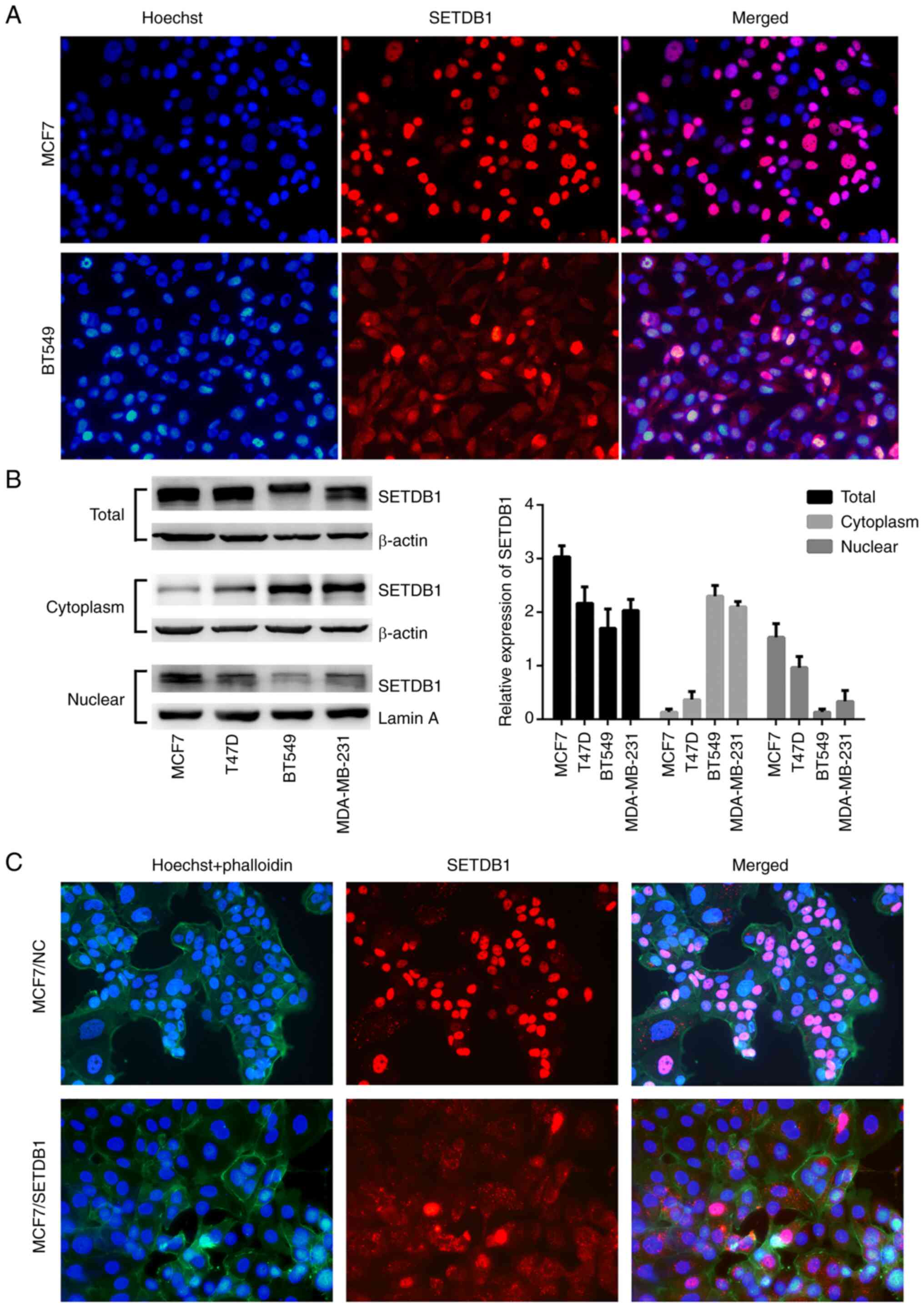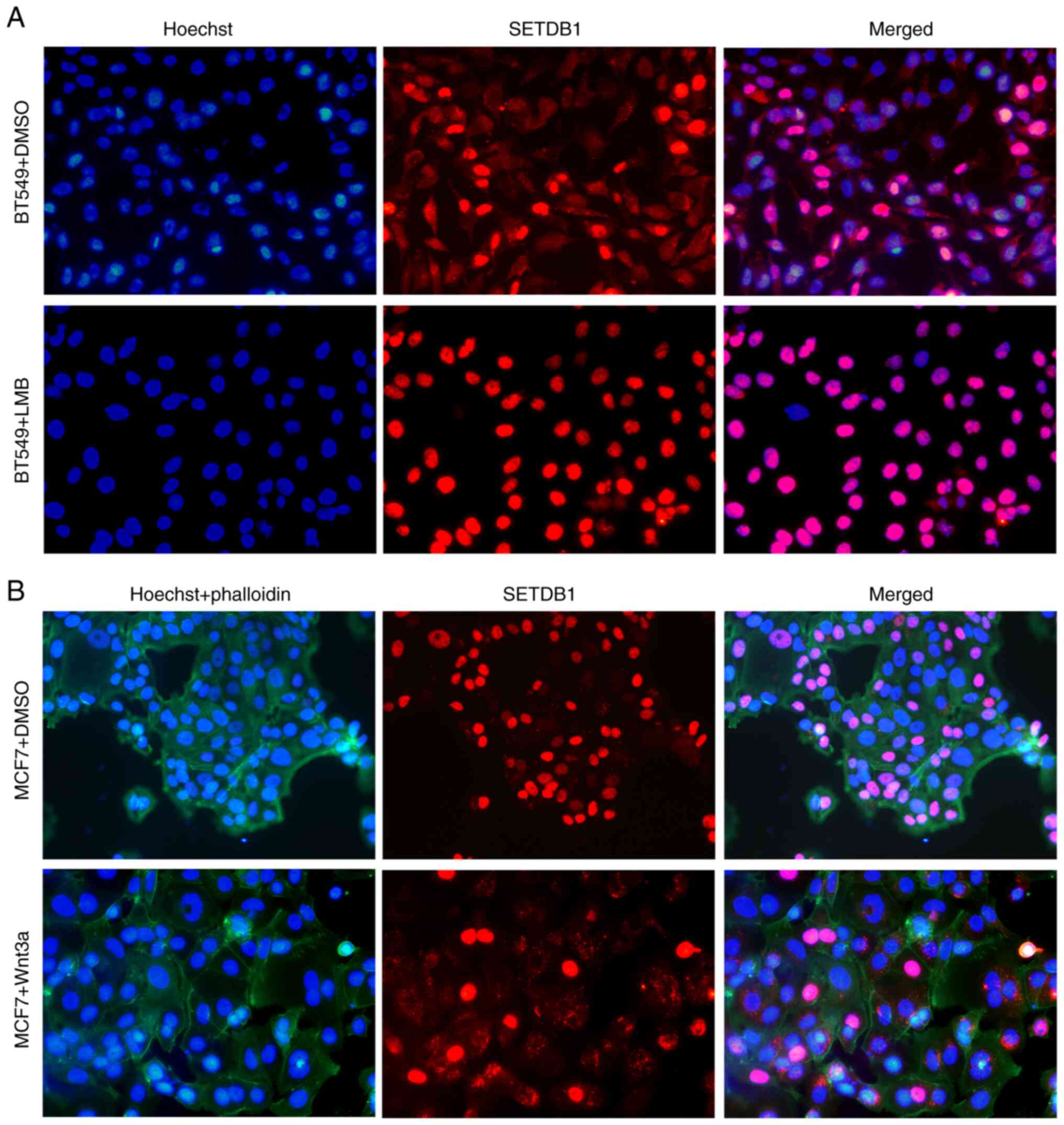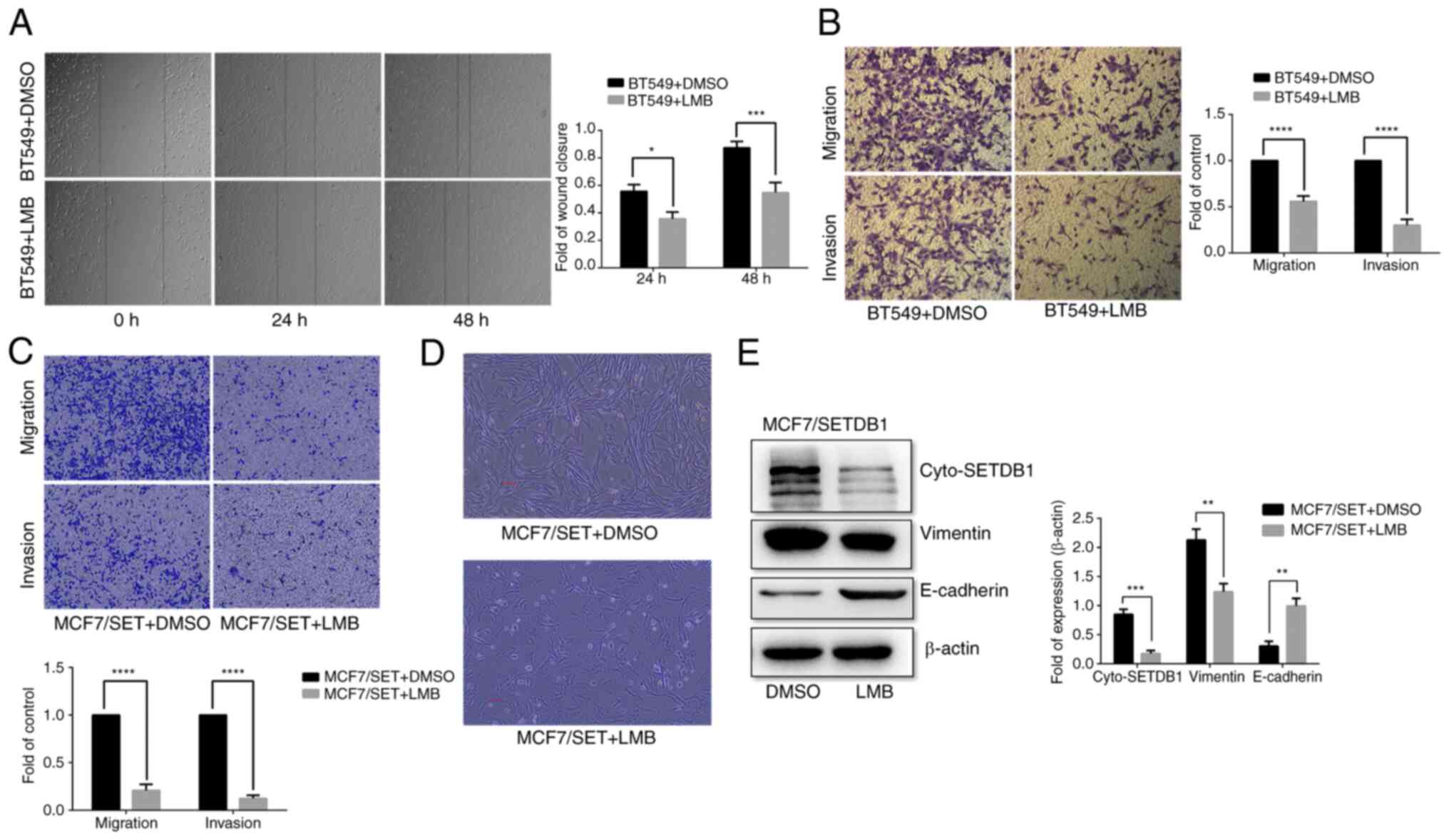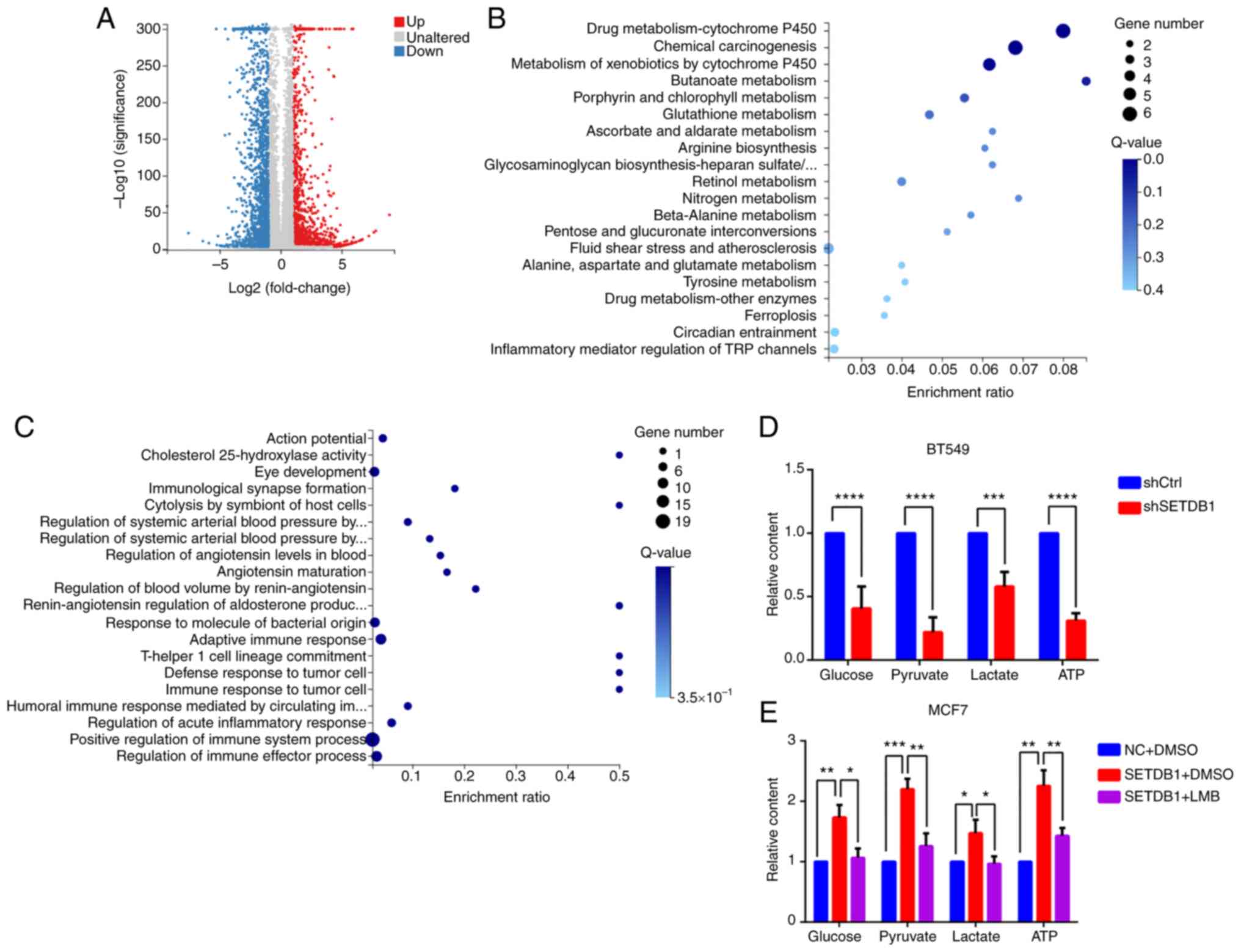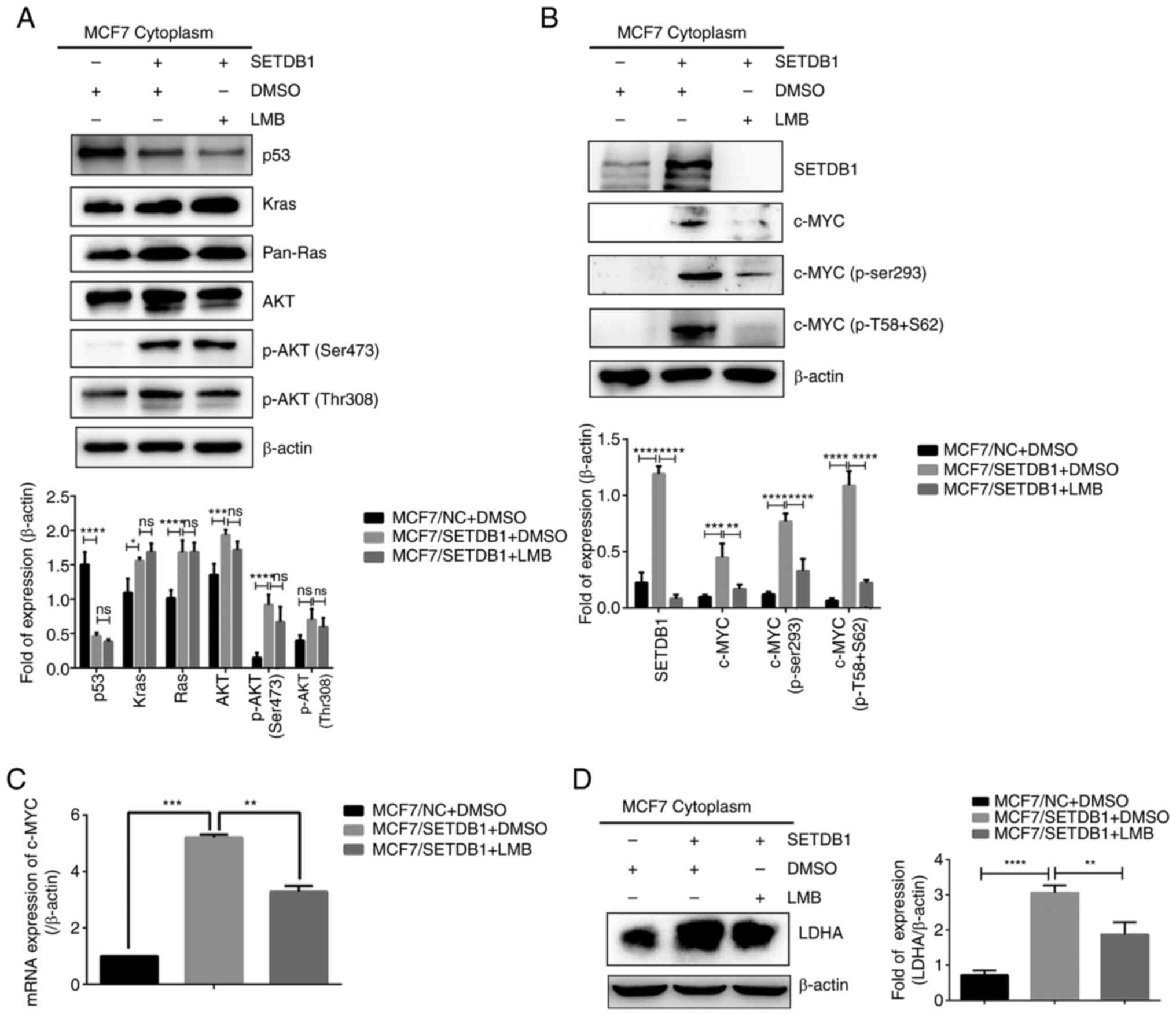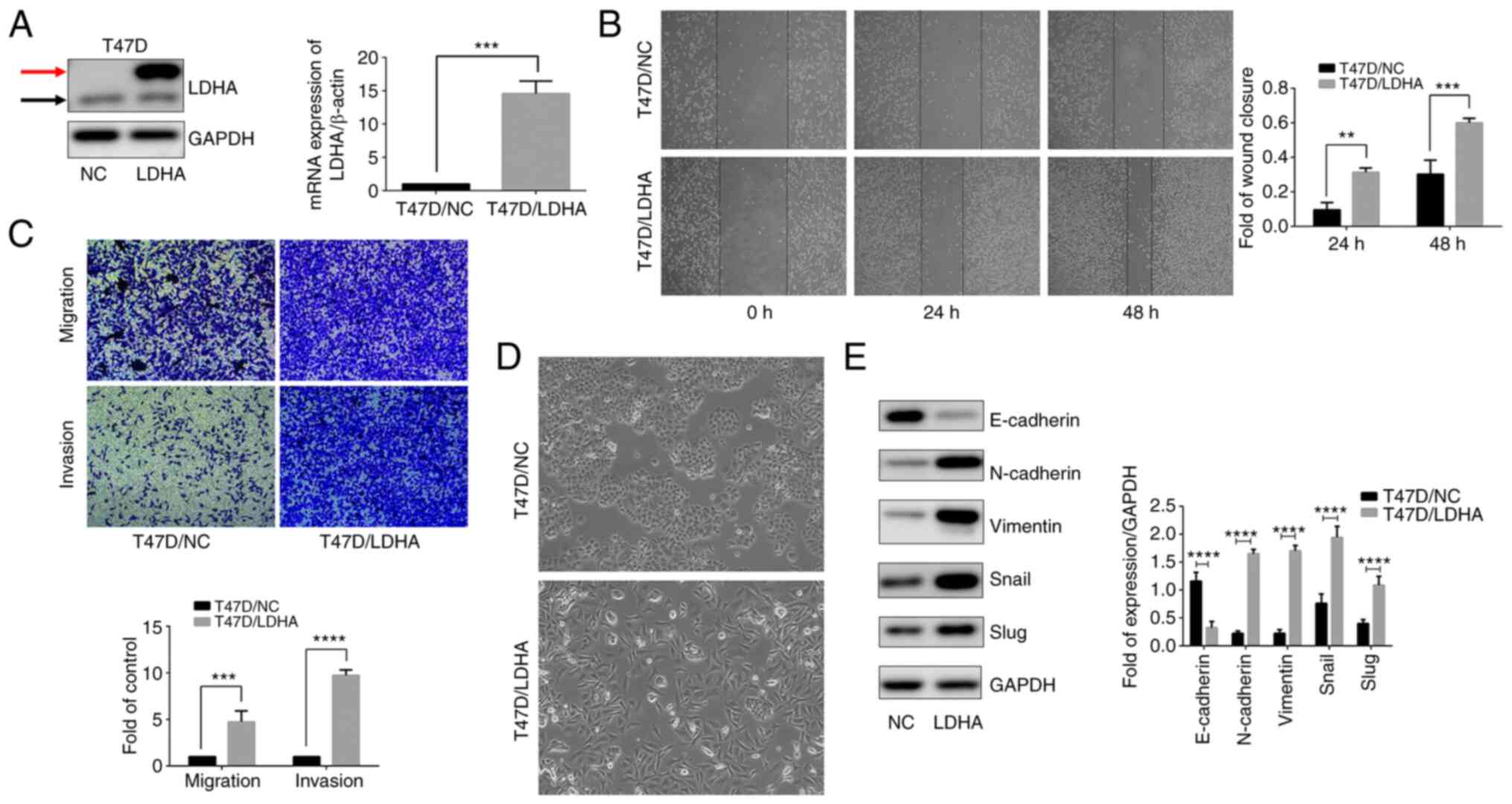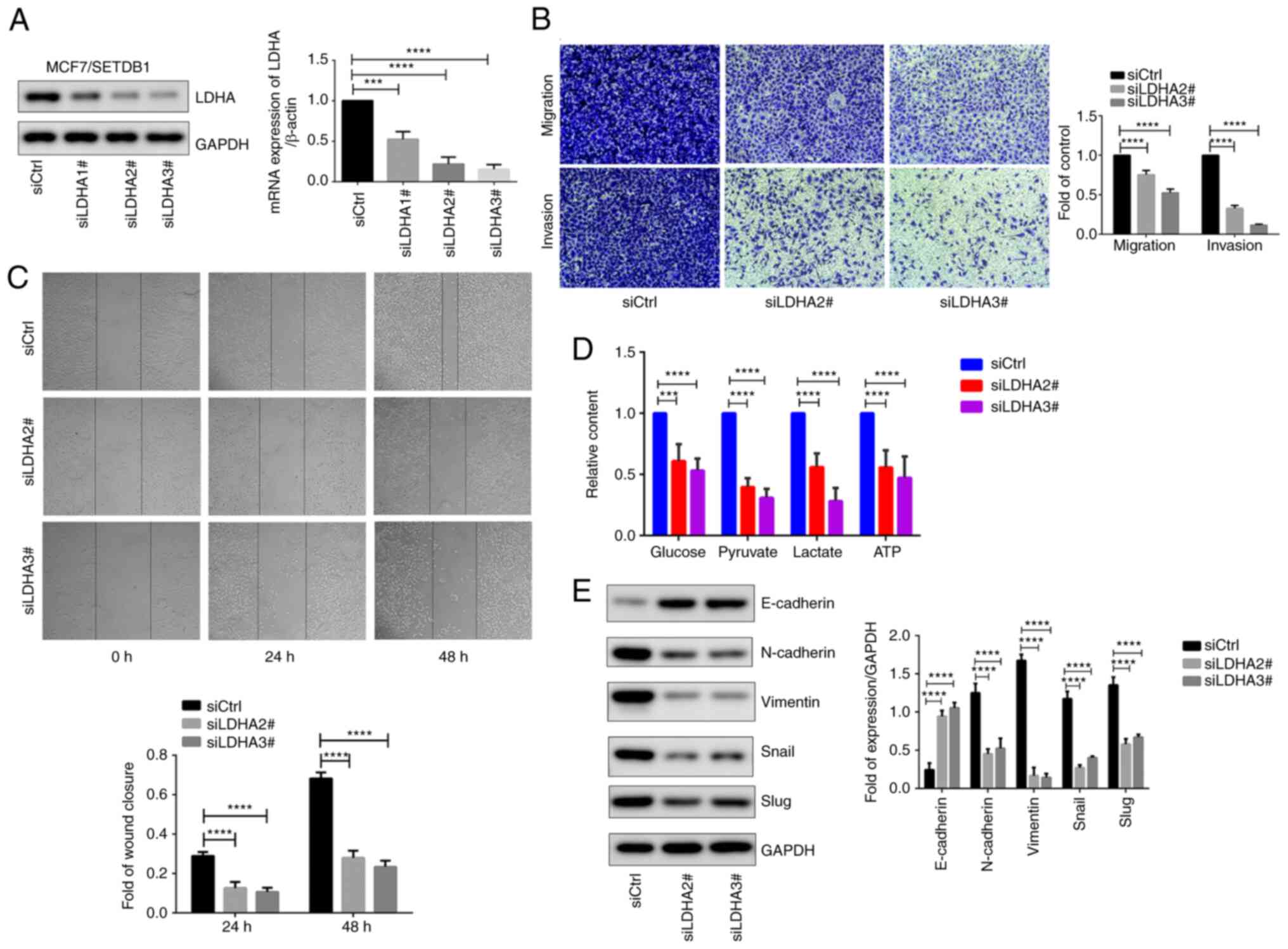|
1
|
Sung H, Ferlay J, Siegel RL, Laversanne M,
Soerjomataram I, Jemal A and Bray F: Global cancer statistics 2020:
GLOBOCAN estimates of incidence and mortality worldwide for 36
cancers in 185 countries. CA Cancer J Clin. 71:209–249. 2021.
View Article : Google Scholar : PubMed/NCBI
|
|
2
|
Hotton J, Lusque A, Leufflen L, Campone M,
Levy C, Honart JF, Mailliez A, Debled M, Gutowski M, Leheurteur M,
et al: Early locoregional breast surgery and survival in de novo
metastatic breast cancer in the multicenter national ESME cohort.
Ann Surg. 277:e153–e161. 2023. View Article : Google Scholar
|
|
3
|
Wang H, An W, Cao R, Xia L,
Erdjument-Bromage H, Chatton B, Tempst P, Roeder RG and Zhang Y:
mAM facilitates conversion by ESET of dimethyl to trimethyl lysine
9 of histone H3 to cause transcriptional repression. Mol Cell.
12:475–487. 2003. View Article : Google Scholar : PubMed/NCBI
|
|
4
|
Schultz DC, Ayyanathan K, Negorev D, Maul
GG and Rauscher FJ III: SETDB1: A novel KAP-1-associated histone
H3, lysine 9-specific methyltransferase that contributes to
HP1-mediated silencing of euchromatic genes by KRAB zinc-finger
proteins. Genes Dev. 16:919–932. 2002. View Article : Google Scholar : PubMed/NCBI
|
|
5
|
Rodriguez-Paredes M, Martinez de Paz A,
Simó-Riudalbas L, Sayols S, Moutinho C, Moran S, Villanueva A,
Vázquez-Cedeira M, Lazo PA, Carneiro F, et al: Gene amplification
of the histone methyltransferase SETDB1 contributes to human lung
tumorigenesis. Oncogene. 33:2807–2813. 2014. View Article : Google Scholar :
|
|
6
|
Cruz-Tapias P, Zakharova V,
Perez-Fernandez OM, Mantilla W, Ramírez-Clavijo S and Ait-Si-Ali S:
Expression of the major and pro-oncogenic H3K9 lysine
methyltransferase SETDB1 in non-small cell lung cancer. Cancers
(Basel). 11:11342019. View Article : Google Scholar : PubMed/NCBI
|
|
7
|
Wong CM, Wei L, Law CT, Ho DW, Tsang FH,
Au SL, Sze KM, Lee JM, Wong CC and Ng IO: Up-regulation of histone
methyltransferase SETDB1 by multiple mechanisms in hepatocellular
carcinoma promotes cancer metastasis. Hepatology. 63:474–487. 2016.
View Article : Google Scholar
|
|
8
|
Fazio M, van Rooijen E, Mito JK, Modhurima
R, Weiskopf E, Yang S and Zon LI: Recurrent co-alteration of HDGF
and SETDB1 on chromosome 1q drives cutaneous melanoma progression
and poor prognosis. Pigment Cell Melanoma Res. 34:641–647. 2021.
View Article : Google Scholar :
|
|
9
|
Ryu TY, Kim K, Kim SK, Oh JH, Min JK, Jung
CR, Son MY, Kim DS and Cho HS: SETDB1 regulates SMAD7 expression
for breast cancer metastasis. BMB Rep. 52:139–144. 2019. View Article : Google Scholar :
|
|
10
|
Strepkos D, Markouli M, Klonou A,
Papavassiliou AG and Piperi C: Histone methyltransferase SETDB1: A
common denominator of tumorigenesis with therapeutic potential.
Cancer Res. 81:525–534. 2021. View Article : Google Scholar
|
|
11
|
Liu L, Kimball S, Liu H, Holowatyj A and
Yang ZQ: Genetic alterations of histone lysine methyltransferases
and their significance in breast cancer. Oncotarget. 6:2466–2482.
2015. View Article : Google Scholar
|
|
12
|
Xiao JF, Sun QY, Ding LW, Chien W, Liu XY,
Mayakonda A, Jiang YY, Loh XY, Ran XB, Doan NB, et al: The
c-MYC-BMI1 axis is essential for SETDB1-mediated breast
tumourigenesis. J Pathol. 246:89–102. 2018. View Article : Google Scholar
|
|
13
|
Regina C, Compagnone M, Peschiaroli A,
Lena A, Annicchiarico-Petruzzelli M, Piro MC, Melino G and Candi E:
Setdb1, a novel interactor of ΔNp63, is involved in breast
tumorigenesis. Oncotarget. 7:28836–28848. 2016. View Article : Google Scholar
|
|
14
|
Zhang H, Cai K, Wang J, Wang X, Cheng K,
Shi F, Jiang L, Zhang Y and Dou J: MiR-7, inhibited indirectly by
lincRNA HOTAIR, directly inhibits SETDB1 and reverses the EMT of
breast cancer stem cells by downregulating the STAT3 pathway. Stem
Cells. 32:2858–2868. 2014. View Article : Google Scholar
|
|
15
|
Wu M, Fan B, Guo Q, Li Y, Chen R, Lv N,
Diao Y and Luo Y: Knockdown of SETDB1 inhibits breast cancer
progression by miR-381-3p-related regulation. Biol Res. 51:392018.
View Article : Google Scholar
|
|
16
|
Tachibana K, Gotoh E, Kawamata N, Ishimoto
K, Uchihara Y, Iwanari H, Sugiyama A, Kawamura T, Mochizuki Y,
Tanaka T, et al: Analysis of the subcellular localization of the
human histone methyltransferase SETDB1. Biochem Biophys Res Commun.
465:725–731. 2015. View Article : Google Scholar
|
|
17
|
Cho S, Park JS and Kang YK: Regulated
nuclear entry of over-expressed Setdb1. Genes Cells. 18:694–703.
2013. View Article : Google Scholar
|
|
18
|
Beyer S, Pontis J, Schirwis E, Battisti V,
Rudolf A, Le Grand F and Ait-Si-Ali S: Canonical Wnt signalling
regulates nuclear export of Setdb1 during skeletal muscle terminal
differentiation. Cell Discov. 2:160372016. View Article : Google Scholar
|
|
19
|
Guo J, Dai X, Laurent B, Zheng N, Gan W,
Zhang J, Guo A, Yuan M, Liu P, Asara JM, et al: AKT methylation by
SETDB1 promotes AKT kinase activity and oncogenic functions. Nat
Cell Biol. 21:226–237. 2019. View Article : Google Scholar
|
|
20
|
Wang G, Long J, Gao Y, Zhang W, Han F, Xu
C, Sun L, Yang SC, Lan J, Hou Z, et al: SETDB1-mediated methylation
of Akt promotes its K63-linked ubiquitination and activation
leading to tumorigenesis. Nat Cell Biol. 21:214–225. 2019.
View Article : Google Scholar
|
|
21
|
Yang W, Su Y, Hou C, Chen L, Zhou D, Ren
K, Zhou Z, Zhang R and Liu X: SETDB1 induces epithelial-mesenchymal
transition in breast carcinoma by directly binding with Snail
promoter. Oncol Rep. 41:1284–1292. 2019.
|
|
22
|
Livak KJ and Schmittgen TD: Analysis of
relative gene expression data using real-time quantitative PCR and
the 2(-Delta Delta C(T)) method. Methods. 25:402–408. 2001.
View Article : Google Scholar
|
|
23
|
Hanahan D and Weinberg RA: Hallmarks of
cancer: The next generation. Cell. 144:646–674. 2011. View Article : Google Scholar
|
|
24
|
DeBerardinis RJ and Chandel NS:
Fundamentals of cancer metabolism. Sci Adv. 2:e16002002016.
View Article : Google Scholar
|
|
25
|
Pavlova NN and Thompson CB: The emerging
hallmarks of cancer metabolism. Cell Metab. 23:27–47. 2016.
View Article : Google Scholar
|
|
26
|
Shim H, Dolde C, Lewis BC, Wu CS, Dang G,
Jungmann RA, Dalla-Favera R and Dang CV: c-Myc transactivation of
LDH-A: Implications for tumor metabolism and growth. Proc Natl Acad
Sci USA. 94:6658–6663. 1997. View Article : Google Scholar
|
|
27
|
Shi MY, Wang Y, Shi Y, Tian R, Chen X,
Zhang H, Wang K, Chen Z and Chen R: SETDB1-mediated CD147-K71
di-methylation promotes cell apoptosis in non-small cell lung
cancer. Genes Dis. 11:978–992. 2023. View Article : Google Scholar
|
|
28
|
Kouzarides T: Chromatin modifications and
their function. Cell. 128:693–705. 2007. View Article : Google Scholar
|
|
29
|
Dawson MA and Kouzarides T: Cancer
epigenetics: From mechanism to therapy. Cell. 150:12–27. 2012.
View Article : Google Scholar
|
|
30
|
Lee ST, Li Z, Wu Z, Aau M, Guan P,
Karuturi RK, Liou YC and Yu Q: Context-specific regulation of NF-κB
target gene expression by EZH2 in breast cancers. Mol Cell.
43:798–810. 2011. View Article : Google Scholar
|
|
31
|
Lehmann BD, Bauer JA, Chen X, Sanders ME,
Chakravarthy AB, Shyr Y and Pietenpol JA: Identification of human
triple-negative breast cancer subtypes and preclinical models for
selection of targeted therapies. J Clin Invest. 121:2750–2767.
2011. View Article : Google Scholar :
|
|
32
|
Tsusaka T, Shimura C and Shinkai Y: ATF7IP
regulates SETDB1 nuclear localization and increases its
ubiquitination. EMBO Rep. 20:e482972019. View Article : Google Scholar :
|
|
33
|
Zheng Q, Cao Y, Chen Y, Wang J, Fan Q,
Huang X, Wang Y, Wang T, Wang X, Ma J and Cheng J: Senp2 regulates
adipose lipid storage by de-SUMOylation of Setdb1. J Mol Cell Biol.
10:258–266. 2018. View Article : Google Scholar
|
|
34
|
Liu S, Brind'Amour J, Karimi MM, Shirane
K, Bogutz A, Lefebvre L, Sasaki H, Shinkai Y and Lorincz MC: Setdb1
is required for germline development and silencing of
H3K9me3-marked endogenous retroviruses in primordial germ cells.
Genes Dev. 28:2041–2055. 2014. View Article : Google Scholar
|
|
35
|
Collins PL, Kyle KE, Egawa T, Shinkai Y
and Oltz EM: The histone methyltransferase SETDB1 represses
endogenous and exogenous retroviruses in B lymphocytes. Proc Natl
Acad Sci USA. 112:8367–8372. 2015. View Article : Google Scholar
|
|
36
|
Pasquarella A, Ebert A, Pereira de Almeida
G, Hinterberger M, Kazerani M, Nuber A, Ellwart J, Klein L,
Busslinger M and Schotta G: Retrotransposon derepression leads to
activation of the unfolded protein response and apoptosis in pro-B
cells. Development. 143:1788–1799. 2016.
|
|
37
|
Martin FJ, Xu Y, Lohmann F, Ciccone DN,
Nicholson TB, Loureiro JJ, Chen T and Huang Q: KMT1E-mediated
chromatin modifications at the FcγRIIb promoter regulate thymocyte
development. Genes Immun. 16:162–169. 2015. View Article : Google Scholar
|
|
38
|
Takikita S, Muro R, Takai T, Otsubo T,
Kawamura YI, Dohi T, Oda H, Kitajima M, Oshima K, Hattori M, et al:
A histone methyltransferase ESET is critical for T cell
development. J Immunol. 197:2269–2279. 2016. View Article : Google Scholar
|
|
39
|
Yizhak K, Le Dévédec SE, Rogkoti VM,
Baenke F, de Boer VC, Frezza C, Schulze A, van de Water B and
Ruppin E: A computational study of the Warburg effect identifies
metabolic targets inhibiting cancer migration. Mol Syst Biol.
10:7442014. View Article : Google Scholar
|
|
40
|
Warburg O: On the origin of cancer cells.
Science. 123:309–314. 1956. View Article : Google Scholar
|
|
41
|
Gao H, Yu Z, Bi D, Jiang L, Cui Y, Sun J
and Ma R: Akt/PKB interacts with the histone H3 methyltransferase
SETDB1 and coordinates to silence gene expression. Mol Cell
Biochem. 305:35–44. 2007. View Article : Google Scholar
|
|
42
|
Liu T, Chen X, Li T, Li X, Lyu Y, Fan X,
Zhang P and Zeng W: Histone methyltransferase SETDB1 maintains
survival of mouse spermatogonial stem/progenitor cells via
PTEN/AKT/FOXO1 pathway. Biochim Biophys Acta Gene Regul Mech.
1860:1094–1102. 2017. View Article : Google Scholar
|
|
43
|
Noh HJ, Kim KA and Kim KC: p53
down-regulates SETDB1 gene expression during paclitaxel
induced-cell death. Biochem Biophys Res Commun. 446:43–48. 2014.
View Article : Google Scholar
|
|
44
|
Chen K, Zhang F, Ding J, Liang Y, Zhan Z,
Zhan Y, Chen LH and Ding Y: Histone methyltransferase SETDB1
promotes the progression of colorectal cancer by inhibiting the
expression of TP53. J Cancer. 8:3318–3330. 2017. View Article : Google Scholar
|
|
45
|
Osaka N and Sasaki AT: Beyond Warburg:
LDHA activates RAC for tumour growth. Nat Metab. 4:1623–1625. 2022.
View Article : Google Scholar
|
|
46
|
Hou X, Shi X, Zhang W, Li D, Hu L, Yang J,
Zhao J, Wei S, Wei X, Ruan X, et al: LDHA induces EMT gene
transcription and regulates autophagy to promote the metastasis and
tumorigenesis of papillary thyroid carcinoma. Cell Death Dis.
12:3472021. View Article : Google Scholar
|
|
47
|
Cai H, Li J, Zhang Y, Liao Y, Zhu Y, Wang
C and Hou J: LDHA promotes oral squamous cell carcinoma progression
through facilitating glycolysis and epithelial-mesenchymal
transition. Front Oncol. 9:14462019. View Article : Google Scholar
|
|
48
|
Herz HM, Garruss A and Shilatifard A: SET
for life: Biochemical activities and biological functions of SET
domain-containing proteins. Trends Biochem Sci. 38:621–639. 2013.
View Article : Google Scholar
|
|
49
|
Van Duyne R, Easley R, Wu W, Berro R,
Pedati C, Klase Z, Kehn-Hall K, Flynn EK, Symer DE and Kashanchi F:
Lysine methylation of HIV-1 Tat regulates transcriptional activity
of the viral LTR. Retrovirology. 5:402008. View Article : Google Scholar
|
|
50
|
Fei Q, Shang K, Zhang J, Chuai S, Kong D,
Zhou T, Fu S, Liang Y, Li C, Chen Z, et al: Histone
methyltransferase SETDB1 regulates liver cancer cell growth through
methylation of p53. Nat Commun. 6:86512015. View Article : Google Scholar
|
|
51
|
Zhu H, Yang Y, Wang L, Xu X, Wang T and
Qian H: Leptomycin B inhibits the proliferation, migration, and
invasion of cultured gastric carcinoma cells. Biosci Biotechnol
Biochem. 84:290–296. 2020. View Article : Google Scholar
|
|
52
|
Batham J, Lim PS and Rao S: SETDB-1: A
potential epigenetic regulator in breast cancer metastasis. Cancers
(Basel). 11:11432019. View Article : Google Scholar
|















